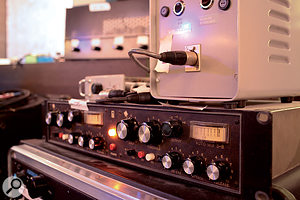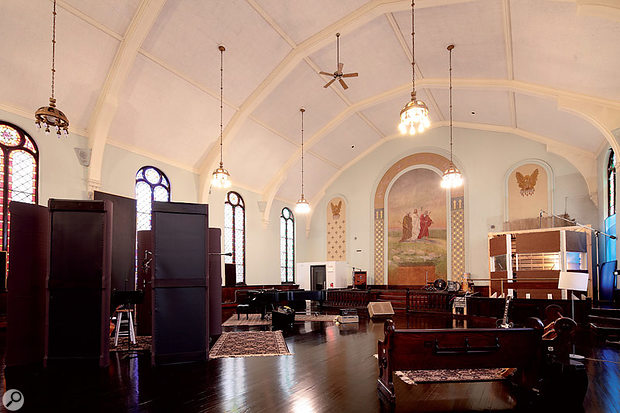Henry Hirsch opened up his Waterfront Studios in their current location in the Hudson Valley, upstate New York, in 2008, merely two hours by train north of the bustling scene around Manhattan and Brooklyn. However, it wasn't the first studio the engineer/keyboardist/bassist had built in his career. Hirsch had been involved in building Lenny Kravitz's Roxie Studio in Miami and Takeshi Kobayashi's studio in New York, but, more importantly, had been running his own Waterfront Studios in their previous location in Hoboken, New Jersey, for many years.
 The large control room at Waterfront is based around a beautifully restored Helios mixer.
The large control room at Waterfront is based around a beautifully restored Helios mixer.
Having started his career as a professional musician in Berlin in the late '70s, Hirsch worked as a pianist and arranger for a couple of years, before relocating to the US and opening Waterfront in Hoboken. Even then, he had a strong interest in vintage recording equipment and techniques, which was quite unusual in a time when everybody else seemed to care much more for drum machines, digital synthesizers, exciters and samplers.
 A close-up showing the Helios EQ and preamp controls.Then, in 1985, Henry Hirsch met a teenage aspiring musician called Lenny Kravitz, and the rest is — as they say — history. Something clicked between the two, and when Kravitz scored his record deal a couple of years later, they began a collaboration which led to a string of hit records. Even today, almost 25 years after the release of Lenny's debut Let Love Rule, the fruits of this collaboration sound remarkably fresh and distinctive. And who knows, perhaps our current views on vintage and valve equipment might be different if Henry Hirsch and Lenny Kravitz hadn't pioneered the reintroduction of classic gear to the recording process? As well as Kravitz's work, Henry Hirsch has engineered a number of other internationally successful productions, such as Vanessa Paradis' self-titled third album and Madonna's chart-topping single 'Justify My Love'.
A close-up showing the Helios EQ and preamp controls.Then, in 1985, Henry Hirsch met a teenage aspiring musician called Lenny Kravitz, and the rest is — as they say — history. Something clicked between the two, and when Kravitz scored his record deal a couple of years later, they began a collaboration which led to a string of hit records. Even today, almost 25 years after the release of Lenny's debut Let Love Rule, the fruits of this collaboration sound remarkably fresh and distinctive. And who knows, perhaps our current views on vintage and valve equipment might be different if Henry Hirsch and Lenny Kravitz hadn't pioneered the reintroduction of classic gear to the recording process? As well as Kravitz's work, Henry Hirsch has engineered a number of other internationally successful productions, such as Vanessa Paradis' self-titled third album and Madonna's chart-topping single 'Justify My Love'.
Away From It All
 Henry Hirsch is best known for his collaborations with Lenny Kravitz, and for pioneering the rediscovery of vintage recording gear and techniques.
Henry Hirsch is best known for his collaborations with Lenny Kravitz, and for pioneering the rediscovery of vintage recording gear and techniques.
When Hirsch wanted to relocate his studio a few years ago, he was looking for a facility that provided privacy as well as uncompromising sound, and he found these goals fulfilled in a 19th Century church in the small town of Hudson — at a price which, as he says, would be the "equivalent of a small apartment in Manhattan”. Luckily, the space did not need much acoustic treatment, as the previous congregation had already installed acoustic tiles to enhance speech intelligibility during church services. Interestingly, the large live area in the church has a similar floor space and reverb time to Abbey Road's Studio 2.
 The outboard collection includes a pair of rare Quad Eight AM 3B compressors.In this beautiful environment, which retains much of its original charm, Hirsch installed an equipment collection which encompasses the most coveted vintage pieces, as well as custom-designed gear tailored to his specific needs. The centrepiece is a fully discrete 26-input Helios console which was restored by Bomb Factory and Anamod founder Dave Amels. The desk is accompanied by 24- and two-track tape recorders by 3M and a small, very select outboard collection which includes two pairs of NTP 179-120 and Quad Eight Auto Mix 3B compressors. Henry also keeps an Anamod AM660 in his arsenal, mostly for vocal duties, as well as the Realios A9033, a special preamp with only 20dB gain, designed specifically for vocal recordings with a U47, and developed by Dave Amels at Hirsch's request. The studios' lockers hold an exquisite microphone collection, including Neumann U47 and M49s, as well as rare ribbons such as the RCA KU3. Waterfront also offers a collection of vintage instruments, including a Steinway Concert D, Hammond B3, Rhodes, Wurlitzer, and a vintage Ludwig drum kit, amongst others. But all this equipment is simply meant to capture the playing with the highest possible quality, as the studio's main focus is to offer an environment for relaxed performance.
The outboard collection includes a pair of rare Quad Eight AM 3B compressors.In this beautiful environment, which retains much of its original charm, Hirsch installed an equipment collection which encompasses the most coveted vintage pieces, as well as custom-designed gear tailored to his specific needs. The centrepiece is a fully discrete 26-input Helios console which was restored by Bomb Factory and Anamod founder Dave Amels. The desk is accompanied by 24- and two-track tape recorders by 3M and a small, very select outboard collection which includes two pairs of NTP 179-120 and Quad Eight Auto Mix 3B compressors. Henry also keeps an Anamod AM660 in his arsenal, mostly for vocal duties, as well as the Realios A9033, a special preamp with only 20dB gain, designed specifically for vocal recordings with a U47, and developed by Dave Amels at Hirsch's request. The studios' lockers hold an exquisite microphone collection, including Neumann U47 and M49s, as well as rare ribbons such as the RCA KU3. Waterfront also offers a collection of vintage instruments, including a Steinway Concert D, Hammond B3, Rhodes, Wurlitzer, and a vintage Ludwig drum kit, amongst others. But all this equipment is simply meant to capture the playing with the highest possible quality, as the studio's main focus is to offer an environment for relaxed performance.Building A Community
 Waterfront was built as a church, and signs of its former role are everywhere!
Waterfront was built as a church, and signs of its former role are everywhere!
Henry Hirsch, who, in his own words, is embarking on the "second half of his career", is making Waterfront's services available not only to established artists, but also to a younger generation working on a tight budget. He is giving recording classes to local students and helping to foster a creative community in Hudson. Recently, the Waterfront team, which also includes Rachel Alina and Matt Teacher, have been working on a number of notable productions, including Joan Osborne's Grammy nominated album Bring It On Home, a solo piano record by John Medeski and Mono's latest release, For My Parents.

